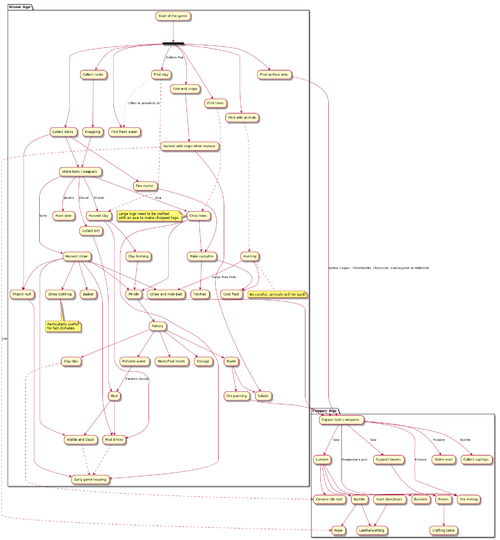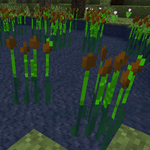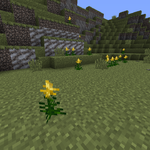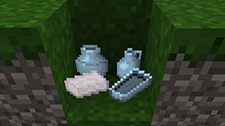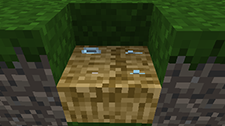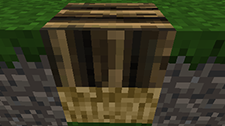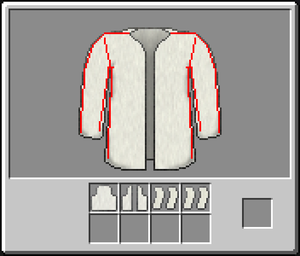石器時代のススメ
Contents
TFC+へようこそ!
TerraFirmaCraft+ は、Minecraftを"サバイバルのあるべき姿"に再構築し、リアリティを高めることに重点を置いています。バニラでは複雑さやディテールが足りないと感じている熟練プレイヤーや、バニラでは味わえない高いリアリズムを求める人に向いています。
ここでは、TFC+とバニラの違いに焦点を当てて、新参プレイヤーが始めたての頃に何をすべきかを解説しています。既にオリジナルのTerraFirmaCraftをプレイしたことのあるプレイヤーは、TFCとの違い(英:Differences from TFC)を参照してください。なにか問題や質問がある場合は、ttps://discord.gg/GhqaFgQ Discordやttps://reddit.com/r/TFCPlus Subredditへ連絡してください。
TFC+は多少翻訳されてはいますが、まだまだ未完成です。翻訳を手伝いたい場合は、翻訳Translation ページを参照してください。
このガイドでは、Terrafirmacraft+をインストールしていることを前提としています。
開始直後について
HUDとステータス情報
新しくワールドを始めると、HUDがバニラで慣れ親しんだものとは全く違うことに気づくかもしれません。このセクションでは、Terrafirmacraft+でのHUDの様々なゲージや項目について解説します。
体力
![]()
初めに目につくバニラとの違いは体力ゲージです。TFC+ではハートの代わりに、HPが赤いゲージで表示されます。HPは最大1000からスタートしますが、これは栄養状態やレベルなどの様々な要因によって変化します。満腹ゲージが25%以上であれば、時間と共にゆっくりと回復していきます。完全に満腹になってもすぐに回復はしません。温泉に入ったり、滅菌包帯(英:Sterile Bandages)を使用することで治癒を早めることができます。
また、プレイヤーはたびたび傷(英: wounded)を負い、様々なデメリットを受けます。一度に20%以上のダメージを受けた場合に傷を負います。骨折したままだと動きが遅くなり、傷を放置するとその間徐々にダメージを受けます。骨折は打撃系のダメージや落下ダメージによってのみ発生し、傷は刺突系のダメージ、切り傷は斬撃系のダメージによって発生します。傷を癒すには薬(英:medicine)を参照してください。
空腹
![]()
満腹度はバニラの骨付き肉の代わりに緑色のゲージで表します。
食べ物それぞれに「満腹度」が設定されていたバニラとは異なり、TFC+の空腹システムは食べ物の重さを参照します(肉も魚も野菜も、食べる重さが同じなら回復する満腹度も一緒です)。TFC+では、オンスという帝国単位の値を使用しています。もっとも、この値は現実や他のゲームの値とは関係ありませんので、混乱するようなら「~口分」や「~個分」として考えてください。TFC+では食べ物は1スタック160オンスまで重ねられます。
プレイヤーは動かなくても、数日の間に徐々にお腹が減っていきます。満腹度が一定以下になると、その間「採掘速度低下」や「弱体化」などのデメリットを受け始めます。満腹ゲージが枯渇するとやがて飢餓に苦しみ始め、あっという間に死んでしまいます。
喉の渇き
![]()
TFC+では「渇き」の概念を導入しています。プレイヤーは徐々に喉が渇いていき、最終的には「移動速度低下」や「弱体化」のような効果を受け、完全に脱水状態になると熱中症になります。渇きは青いゲージで表されています。空腹と同様、プレイヤーが動いていなくてもゆっくり喉が渇いていきます。プレイヤーは水場にある新鮮な水しか飲むことができません。そのため、この世界で生き伸びるためには新鮮で飲める水を見つけることが肝要です。 飲める水場には海水にはないガマやスイレンの葉があるので、それを目印にするとよいでしょう。
新鮮な水の下のブロックを右クリックすることで水を飲むことができます。押し続ければ完全に喉が潤うまで飲み続けられます。 (また、現在「他のワールドのホットバーでアイテムを選択していると水が飲めない」というバグが発生しています。他のワールドでも手に何も持っていない状態にしてminecraftを再起動すれば飲めるようになります)
ゲーム序盤の大きな目的として、長距離探索のために真水を持ち運ぶこと、そしてそのために陶器の水差しを作る事があります。
経験値
レベルシステムはそのまま人生経験を表し、レベルが高いほどプレイヤーの最大HPや喉の潤い度、アルコール(英:alcohol)耐性を増加させます。それにより更に大きいダメージに耐えたり、水を飲まずに長く生き延びたり、デメリットを受ける前により多くのアルコールを飲んだりすることができます。
バニラと違ってエンチャントや道具の修理がないので、死んだりしない限り経験値は減りません。
体温
体温は画面右下の温度計で表されます。体温計の緑の部分は過ごしやすい気温の範囲を示しています。プレイヤーの体温は季節や地域の気候、特定のブロックによって影響を受けます。体温が高すぎたり低すぎたりすると、「移動速度低下」や「採掘速度低下」などのデメリットを受けることになり、そして体を冷ますため汗をかいたり、温めるためにカロリーを消費したりするため空腹感や喉の渇きを早く感じるようになります。また藁のベッドで眠ることもできなくなります。
体温は主に衣服で調整します。また、屋根)の下や日陰に入って日差しを遮ったり、洞窟の中にいたりすることでも体温調節を行うことができます。
TFC+のインベントリには4つのタブがあります。バニラのインベントリのようにアイテムを保持したりクラフトしたりする「インベントリタブ」、プレイヤーの各スキルの熟練度を表示する「スキルタブ」、時間や季節、曜日を表示する「時間タブ」、そしてプレイヤーが健康のために最低限食べなければならない栄養素を5つのカテゴリーに分けて表示する「栄養タブ」です。
バニラとは異なり、全てのクラフトはインベントリタブで直接行われます。初めは2x2のグリッドから始めますが、後に作業台を使って3x3に拡張することができます。作業台は実際に置いて使うブロックではなく、3x3グリッドを解放するための特殊なアイテムです。
| | |||
サバイバル一日目:道具・光・衣服
初日の目標は、夜営の準備と長く生き延びるための用意です。自分の周りを見渡して、どんな資源があるのかを確認してください。草や低木、岩が地平線まで伸びる平原であれば、金属片や動物をかなり簡単に見つけることができるかもしれません。もし海岸沿いであれば、海藻や真水は簡単に確保できるでしょう。深い熱帯雨林の真っただ中にいるならば、粘土や淡水、木材が豊富に見つかることでしょう。
できないこと
バニラの時の癖で木を殴っても、木材が手に入らないことに気づくかもしれません。これはTFC+のスキルツリーがバニラと全く異なる構造をしているためです。TFC+には木の道具は存在しないので、頑張って木を殴り倒しても時間の無駄です。鋸がなければ作業台や板を作ることができず、そしてそれは金属から作るしかありません。 そのため、最初の道具は木材ではなく石(英:stone)で作られることになります。
現実とTFC+には木のツルハシや石のツルハシなど存在しません。初めの内は鉱石を掘って採掘したりはできず、その代わりに鉱石片を拾って金属製の道具を作ります。これにより、より多くの鉱石を得るための手段であるツルハシを作る事になります。
ブロックを壊しても、TFC+では砂、砂利、石、そして丸石(英:sand, gravel, stone and cobblestone)は重力の影響を受けるため、土を掘る事はお勧めしません。バニラと異なり、重力の影響を受けたブロックは真下だけでなく、横に滑り落ちることもできます。そのためこれらのブロックから家を作ることはできません。
バニラのminecraftに慣れているプレイヤーなら、TFC+ではどうやってアイテムを保管するのか疑問に思うかもしれません。板を作れるのは金属製のツールを作れるようになった後ですので、初めの内は藁かご、陶製の容器、陶製の大型容器、生皮鞄(英:Straw Basket、Large Vessel、Ceramic Vessel、Raw Hide Bag)のような代替品を使うことになります。
TFC+では無暗に走り回ると余計に飢えと渇きが進むので経済的ではありません。代わりに木の杖を使うことで、走行の半分の速さで動くことができます。木の杖については後述します。
TFC+の松明は可燃性のブロックに火をつけます。松明を使う前に、周囲の草や低木、落ち葉などの可燃性のブロックを取り払っておくことをお勧めします。拠点で明かりをつけるには後述する焚火を使用します。ゲームが進めば、後により安全な光源であるロウソク(英:Candle)を作ることができます。
石と棒
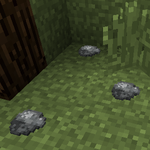
Terrafirmacraft+でまず最初にやるべきことは、木を殴るのではなく地面に散らばっている石や棒切れを集めることです。石が十数個もあれば最初の数日間を生き延びるには十分でしょう。
その際、時々鉱石の小片を見つけるかもしれません。その時は拾った場所をメモしておくことをお勧めします。後で必ず役に立つ時が来ます。
棒は木の下や岸辺の地面に散らばっています。落ち葉を浚ったり、低木を壊すことでも得られます。
ナッピングとは、2つの石を使って石の道具のツールヘッドを作ることです。2つ以上の石を持って右クリックを押すと、ナッピングインターフェイスが開きます。ナッピングの過程で石の破片が零れ落ち、これは様々な道具の材料となります。
| |
||||||
The knapping interface is a 5x5 grid. Clicking on a square of the grid will break off that piece of stone. Be careful where you click - if you make a mistake, you cannot undo it and you will have to start again. If you successfully create a specific shape, a tool head will appear to the right which can then be attached to a stick or a bone in the crafting grid to create a stone tool. While knapping, Stone Flakes might be produced, which can be used to craft arrows later on.
Tip: Some of the tools can be knapped out differently than the below forms, feel free to experiment.
Tip: Completed stone tools do not stack, but tool heads will stack up to 32. At night when you are hiding from monsters, you can knap a handful of each tool head to keep in your inventory. Then during the day when your tool breaks, you can quickly combine another head with a stick or bone for a new tool.
If you successfully create a specific shape, a tool head will appear to the right which can then be attached to a stick or a bone in the crafting grid to create a stone tool.
|
|
|
Wood
Wood is gathered by chopping down trees with an axe. If you break the bottom log of the tree with an axe, it will break the entire tree into logs and sticks. If your axe does not have enough durability to chop down the entire tree, only the top of the tree will be chopped, and the axe will break.
Trees come in two sizes: the normal tree that populates forests and grasslands, which drop regular-sized logs, and the rarer large trees which drop large logs. Large logs can be hewed into regular-sized logs; however, it is not recommended you do this, as large logs are comparatively rare, and can be used for building.
Logs can be stored in a log pile by ⇧ Shift + ![]() Right Click onto the ground. Only regular-sized logs can be used to start a log pile, however, once the log pile is created, it can be used to store large logs, as well.
Right Click onto the ground. Only regular-sized logs can be used to start a log pile, however, once the log pile is created, it can be used to store large logs, as well.
Logs can be crafted into poles with a knife, and poles can be snapped in half to make sticks.
| |
| ||
| | |||
| | |||
| |
| ||
| | |||
Logs can be right clicked with a knife to receive Resin; this can be used to craft various items, such as the Wooden Staff, and the Primitive Bandage. The Wooden Staff is made from Resin combined with a Pole, and gives the player a 15% speed bonus while walking when it is held. This speed bonus is half of the sprinting speed. Because sprinting in Terrafirmacraft+ causes the player to become hungry and thirsty faster, it is recommended to use the Wooden Staff instead of sprinting whenever possible. The Primitive Bandage is used when the player gets wounded; see the Wounds and Medicine section.
| |
| ||
| | |||
| | |||
Weapons
Weapons are important in order to hunt wild animals and defend yourself from monsters at night. Early game weapons, like tools, can be knapped from stone, or, in the case of the Wooden Spear, shaped from a pole. In Terrafirmacraft+, there are three types of damage: Slashing, Piercing, and Crushing. Slashing is effective against Endermen and Zombies. Piercing damage is effective against Bears, Creepers, Endermen, and Wolves, and Crushing is effective against Endermen and Skeletons. Axes deal Slashing damage, Javelins and Spears deal Piercing damage, and Hammers deal Crushing damage. The Knife has two modes, Stabbing and Slashing, which deal Piercing and Slashing damage respectively.
|
|
Javelin heads need to be crafted with a Pole in order to create the full Javelin, while Stone Hammers, like tools, need to be crafted with a Stick or a Bone.
Wooden Spears are an weaker version of the Stone Javelin. They can be crafted from a pole and a knife.
| |
| ||
| | |||
| | |||
Wooden Spears and Javelins will automatically refill from your inventory after one is thrown.
Hunting and Foraging
Finding a source of food and water is important for your long term survival. Only fresh water can be drunk; the process of finding and drinking fresh water is described in the Thirst section.
Seaweed
A good source of early-game food - if you are near the shore - is seaweed. Seaweed can be harvested using ![]() Right Click on the block below the seaweed while holding a knife. Once you have a few pieces of seaweed, you can stack them together by hovering over one piece of seaweed and pressing S to stack the seaweed together. Alternatively, the seaweed can be crafted together in the Inventory grid to stack them.
Right Click on the block below the seaweed while holding a knife. Once you have a few pieces of seaweed, you can stack them together by hovering over one piece of seaweed and pressing S to stack the seaweed together. Alternatively, the seaweed can be crafted together in the Inventory grid to stack them.
Meat
If you cannot locate a shore, the next best source of food is meat. Animals can be found clustered in groups around the world. Do not attack them right away! In Terrafirmacraft+, animals are neutral mobs, and will attack the player if the player attacks them. As animals are also much harder to kill than in Vanilla, you should prepare yourself before you attack an animal.
Note: Do not underestimate animals! They have large amounts of knockback and damage. They are not harmless, like in Vanilla!
Stand away some distance from the animal, and hold ![]() Right Click to prepare your spear or javelin. Do not attack the animal directly with the javelin! Hitting an animal with a javelin deals far less damage than throwing it. Release in order to throw it. Be careful, as the animal will now try to attack you. Throw multiple spears in rapid succession, until the animal dies. In Terrafirmacraft+, animals drop as much meat as their body weight. This means that large animals will drop quite a lot of meat. You do not have to worry about picking up all the meat, as a few stacks will suffice for a few days. Be sure to pick up the Raw Hide, too, as it is very useful later.
Right Click to prepare your spear or javelin. Do not attack the animal directly with the javelin! Hitting an animal with a javelin deals far less damage than throwing it. Release in order to throw it. Be careful, as the animal will now try to attack you. Throw multiple spears in rapid succession, until the animal dies. In Terrafirmacraft+, animals drop as much meat as their body weight. This means that large animals will drop quite a lot of meat. You do not have to worry about picking up all the meat, as a few stacks will suffice for a few days. Be sure to pick up the Raw Hide, too, as it is very useful later.
If you are wounded, jump to the Wounds and Medicine section, then come back.
Foraging
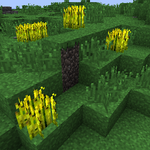
Crops spawn randomly in the wild between the seasons of spring and late summer, and have a chance to regenerate during those seasons every year. Breaking a wild crop will give only seeds if it isn't fully mature, so you should wait until it has reached the last stage of growth before harvesting if you want food. If you can find mature crops, they will serve as a good source of food.
Fruit trees and Berry Bushes can also be found in the wild. To harvest the fruit from a fruit tree or berry bush, ![]() Right Click on their leaves. Berry bushes can be picked up by breaking them, and placed elsewhere later on.
Right Click on their leaves. Berry bushes can be picked up by breaking them, and placed elsewhere later on.
These long-term food sources may be hard to find. Players are reminded that finding crops in Terrafirmacraft+ involves exploring a large area, much larger than required in vanilla - typically, the climate only changes if you travel about 1000 blocks away from an area. This may be confusing to players that are used to Vanilla, because Vanilla uses Biomes to determine the generation of resources, while Terrafirmacraft+ instead uses a climate system. Imagine that you are trying to find a different biome in Vanilla - if you cannot find these food sources, simply travel further, and rely on what you have to feed yourself while exploring. Despite this, it is completely possible to find these sources, and to sustain yourself for a long time.
Grain crops must be refined with a knife to make them into their edible version. This will also return straw.
| |
|
| |
| | |||
| |
In a pinch, mushrooms found in leaf litter can be cut with a knife to make them edible. Only brown mushrooms are safe to eat raw; red mushrooms must first be cooked.
Note: Do not break the leaves of the fruit trees! They take a long time to regrow.
Seeds can later be planted for a long-term food source.
If you have many stacks of food, you can stack them together. This can be done either by crafting the stacks of items together, or by hovering over one stack of food and pressing S (for "stack"). Food will eventually decay, and will have to be preserved for them to last longer. Decay can be cut off of food with a knife automatically by pressing D while your inventory is open, or by crafting the decayed food with the knife. Preservation methods will be discussed later on in this article.
Beekeeping
- Main article: Beekeeping
Wild Beehives occasionally generate on trees. Beehives are a source of Honeycombs, which are useful to make honey, which is a source of food, and also as a source of Wax for Candles. The player may also choose to make their own artificial beehives to gather more honey.
Players cannot open beehives directly. The bees will sting the player if they attempt to open or break the beehive. To calm the bees so that opening the beehive is possible, the player must light a Firepit underneath the beehive to calm the bees and allow the beehive to be opened. Wild Beehives have a Fertile Honeycomb in them; this can be used to create an artificial beehive, or can be cut to gather the honey inside. Once the Fertile Honeycomb is removed from the Wild Beehive, the beehive will collapse and drop some Empty Honeycombs; this can later be melted for Wax, which is an essential component of Candles.
| |
|
| |
| | |||
| | |||
The making of bowls so that you can remove the honey from the honeycomb is discussed later in this article, and the process of creating an artificial hive can be found at the Beekeeping article.
Firepit
- Main article: Firepit
At the end of the first day, you will probably want to create a firepit to make some torches, and cook any meat you've collected so you can eat it. You'll need at least five sticks, some logs to use as fuel, and optionally a piece of straw.
First, you'll need to put two sticks in the grafting grid in a diagonal pattern to make a firestarter.
| |
| ||
| | |||
| |
|||
Once you have a firestarter, throw (Default: Q) three sticks on the ground or other non-flammable block. Make sure they are all stacked on the same block, preferably in the middle. It's possible that your first few tries to light the firepit will not work. You can optionally toss an extra piece of straw in order to make the process faster. Once the firepit appears, drop some logs on to it to quickly add fuel. You can ![]() Right Click on the firepit as long as you aren't holding a firestarter or flint & steel to open its interface. The firestarter can later be upgraded by crafting it with a Bow to produce a Bow Drill, which has a higher effectiveness and durability.
Right Click on the firepit as long as you aren't holding a firestarter or flint & steel to open its interface. The firestarter can later be upgraded by crafting it with a Bow to produce a Bow Drill, which has a higher effectiveness and durability.
If the firepit goes out, you'll need to add some fuel and then ![]() Right Click on it with a firestarter to relight it. Relighting is instant.
Right Click on it with a firestarter to relight it. Relighting is instant.
Once you have a firepit, it is recommended that you make some torches. Torches can be easily lit by pressing ![]() Right Click on a lit Firepit while holding an unlit torch. A placed lit Torch can be used to light unlit torches in the same way.
Right Click on a lit Firepit while holding an unlit torch. A placed lit Torch can be used to light unlit torches in the same way.
| |
|
| |
| | |||
| |
|||
| |
![]() Right Click on a lit torch or lit firepit, or place and
Right Click on a lit torch or lit firepit, or place and ![]() Right Click with a firestarter or flint and steel to light the torch.
Right Click with a firestarter or flint and steel to light the torch.
Warning: Torches can set nearby flammable blocks on fire! They are not meant for indoor use if your shelter is made of wood or straw. Clear the nearby area of grass, undergrowth, trees, and leaves before placing down a torch. Use a Firepit instead to light up your shelter, and later upgrade to Candles.
Straw
Breaking tall grass with a knife yields straw. Straw is highly useful in the early game, as it can be made into shelter, storage, clothing, bandages, splints, and bedding.
Straw can be woven using the same knapping interface as rocks. To begin weaving straw, ![]() Right Click while holding at least five pieces of straw.
Right Click while holding at least five pieces of straw.
The Basket has 9 slots of inventory space. It will drop its items when it is broken. |
The Straw Cloak provides a moderate amount of cold protection. It is useful if you have spawned in a cold environment. |
The Straw Hat provides a slight amount of heat protection, and protects you from the heat of the sun. | |||||||||||||||||||||||||||||||||||||||||||||||||||||||||||||||||||||||||||||||||
The Grass Shirt provides a slight amount of heat protection. |
The Grass Skirt provides a slight amount of heat protection. |
The Grass Sandals give a small speed bonus when on sand. |
Straw can also be crafted into Straw Blocks, which are useful for building huts to hide from mobs at night.
| |
|
| |
| | |||
| |
| ||
Note: Players and mobs are able to move through straw blocks. You cannot use straw blocks to pillar up to safety, as you will simply fall through the block when you try to jump on it. Hostile mobs will not be able to spot you if you are already hiding in a straw block enclosure, but they are able to follow you through straw blocks if they have been aggro'd while you were outside of the straw block.

If you have a piece of Large Raw Hide, you can craft a Straw and Hide bed by placing two Straw Blocks adjacent to each other. Then, ![]() Right Click with the piece of Large Raw Hide in your hand while facing the straw blocks straight-on in order to create a Straw and Hide Bed. This can be used to skip the night. Be aware, through, that you might need to craft clothing in order to sleep in a Straw and Hide Bed, as it will be too uncomfortable to sleep in if you are too hot or too cold.
Right Click with the piece of Large Raw Hide in your hand while facing the straw blocks straight-on in order to create a Straw and Hide Bed. This can be used to skip the night. Be aware, through, that you might need to craft clothing in order to sleep in a Straw and Hide Bed, as it will be too uncomfortable to sleep in if you are too hot or too cold.
If you made it this far, congratulations. You have survived your first day in Terrafirmacraft+, and have the means to survive at night. Do take note that in TFC+, mob spawns are heavily increased, and it is not a good idea to be wandering around at night. It is recommended to stay near a firepit, and perhaps continue with Pottery, if you have a clay source nearby. You may now explore more long-term possibilities for survival, and progress towards the Copper Age.
Beyond The First Day
The days beyond the first day are focused on securing more tools for survival. You will also work your way towards leaving the Stone Age and entering the Copper Age, which will unlock more possibilities for long term survival.
Environment and Seasons
Instead of vanilla biomes, in Terrafirmacraft+ there is a climate system. Rainfall, elevation, distance from the equator, and time of year determine what types of animals, plants, and terrain will generate in an area. Players will always spawn in the northern half of the map, during the season of early summer.
Terrafirmacraft+ adds the four seasons to Minecraft. The seasons affect the ambient temperature, the behavior of animals, and the timing of sunrise and sunset. In winter, unharvested crops will turn back into seeds, trees will lose their leaves, and new saplings that are not evergreen will not grow. In spring, long grass, flowers, rocks, and saplings will regenerate. In summer, crops will respawn randomly over the world, and can be harvested for seeds. In autumn, trees will turn brown, and the ambient temperature will begin to fall. The player must prepare for the four seasons adequately, and the unique challenges that each provide, such as the heat of summer, especially if the player is in a tropical region, and preparing the cold of winter, by building shelter and sewing clothes.
Areas around the equator tend to be wetter and hotter, and eventually becomes tropical, then temperate, then boreal, and finally polar at 27000 blocks North or South.
Rivers generate along biome borders, and are much larger than Vanilla. Their riverbeds will contain clay deposits that will be useful if one spawns in a climate too dry to spawn clay.
Terrafirmacraft+ also introduces the idea of Regions. Instead of biomes, Regions are what determines what trees, plants, and animals spawns in an area. For example, Black-Eyed Peas can only be found in Africa. Along the edges of regions, huge mountain ranges will generate.
Pottery
Clay generates near ponds and in riverbeds across the world. It can be distinguished from dirt from a distance by the existence of yellow Goldenrod flowers which only grow on clay. It can be dug with a shovel to obtain clay balls, which can then be shaped into clay items, and fired to make Pottery. Pottery is an important step of progression in Terrafirmacraft+, as it allows fresh water to be transported, Mud to be made, and to create vessels and Gold Pans.
Clay, like Straw and Rocks, has a knapping interface for forming clay items. Hold five clay balls in your hand, and ![]() Right Click to access it.
Right Click to access it.
| |
||||||
The Ceramic Jug allows you to pick up water using |
The Ceramic Vessel has four slots of inventory space for small items. It is essential for progression to the Copper Age. Ceramic Vessels can only hold grains. |
The Ceramic Bucket is necessary for picking up water to create Mud. | |||||||||||||||||||||||||||||||||||||||||||||||||||||||||||||||||||||||||||||||||||
Ceramic Bowls can be used for the creation of Salads, or to craft a Gold Pan. |
Large Vessels are an early game Barrel. Large Vessels can contain 9 items, as well as liquids, and can be carried on the player's back. They can be mounted on a Firepit in order to melt items, such as Empty Honeycombs into Wax. Large Vessels are also a part of the Still. |
After you have made a clay item, it must be fired before it can be used. To do this, you will need to make a Pit Kiln.
Pit Kiln
To make a Pit Kiln, dig a pit in the ground, and ⇧ Shift + ![]() Right Click the items to be fired into the pit. Then, add eight straw, then eight logs, by right clicking on the pottery.
Right Click the items to be fired into the pit. Then, add eight straw, then eight logs, by right clicking on the pottery.
- The pit kiln will not work as pictured below. These images are in cross section, with the required surrounding blocks removed for visibility.
The Pit Kiln can now be lit with either a Firestarter or a dropped torch. Lighting a pit kiln using a torch will produce sparks that might burn flammable blocks nearby, so be careful where you build your pit kilns.
The Pit Kiln will take eight hours to complete. Once it is complete, you can ⇧ Shift + ![]() Right Click the items out of the pit kiln. The items can now be used.
Right Click the items out of the pit kiln. The items can now be used.
Sewing
Sewing can be used to craft Raw Hide Bags for carrying around more items, and to create more advanced clothing from materials like Fur.
To begin sewing, one needs a Bone Needle. Bone Needles can be made by repeatedly punching a Stone Block with a bone in your hand. It is recommended to have several bones, as not every bone will drop a Bone Needle. Once a Bone Needle is produced, it can be threaded with a thread, such as Sinew (from killing animals).
| |
| ||
| | |||
| | |||
Leather and the various cloths can be cut into clothing pieces. ![]() Right Click with the clothing pieces with a threaded bone needle in the inventory to show the sewing GUI. Place the necessary clothing pieces into the slots. An image of the clothing will appear. Use the Threaded Bone Needle to trace the thread around the red lines in the image. Using
Right Click with the clothing pieces with a threaded bone needle in the inventory to show the sewing GUI. Place the necessary clothing pieces into the slots. An image of the clothing will appear. Use the Threaded Bone Needle to trace the thread around the red lines in the image. Using ![]() Right Click with a knife on the image will remove a section of thread. Once the red lines on the image is completely traced correctly, and all incorrect parts of the tracing are removed, the completed clothing will appear in the output slot.
Right Click with a knife on the image will remove a section of thread. Once the red lines on the image is completely traced correctly, and all incorrect parts of the tracing are removed, the completed clothing will appear in the output slot.
A Raw Hide Bag is crafted with two Hide Bag Pieces, which can be cut from Raw Hide.
| |
| |||||
| |
|
|
| ||
Wounds and Medicine
In the course of playing, you may get wounded. These are represented by the Cut, Bleeding, Wound, and Fracture status effects. These wounds can be mitigated through the use of medicine. There are several types of medicines. Cuts and Wounds can be healed with bandages but will eventually heal on their own, while Fractures require splints to heal, and will never heal without them. Getting hurt while wounded might make the wounds you already have more severe.
To craft some crude bandages, you will need some straw and some tree resin. Once you've crafted the bandages, hold them in your hand and hold right click to start applying them. A single crude bandage will set the time remaining on the wound to 30 seconds, and is enough to treat minor wounds and bleeding.
| |
|
| |
| | |||
To craft a splint, you need a stick and a piece of any string. A early-game version of string, Straw Cordage, can be made by weaving straw. Alternatively, any kind of string will do, even sinew from an animal. Once you've crafted a splint, hold it in your hand and hold right click to start splinting your fracture. A single splint should be enough for minor fractures, and will remove the movement penalty from the fracture itself while allowing the timer on that fracture to tick down. A fracture's movement speed reduction can also be mitigated through the use of a wooden staff, which can be crafted with a pole and a piece of resin. Holding the staff while walking will allow you to walk normally, ignoring the movement speed reduction as long as the staff is held.
| |
| |||||
| |
|
| |
| | |||
| |
| ||
| | |||
| | |||
You can check if a wound has been healed by opening your inventory and looking at the status effect panel: if it displays a lowercase "t" near the wound, it means the wound has been treated and is healing. In case your wounds are more severe and a single bandage or splint is not enough, you can just keep applying bandages or splints as needed. Note that each medical item will only heal one wound, so if you had a Wound and a Cut at the same time you'd need to use at least two bandages.
Storage
You may now have gathered too many items to carry around in your inventory. Unlike Vanilla, in TFC+, chests are locked behind metal saws. In the early game, one must resort to alternatives.
One of the easiest to make storage items is the Straw Basket. It can contain 9 slots of solid items, but cannot contain liquids. Large Ceramic Vessels and Ceramic Vessels can be crafted from Clay. The Large Ceramic Vessel can contain liquids or 9 slots of solid items. Ceramic Vessels are portable, and can contain four slots of small items, meaning items that are too big for it will not fit. The Raw Hide Bag can contain six slots of items.
Shelter
By now, you will have established your tools, have some food, and have portable fresh water to explore the world. You will now want to establish your shelter so you have somewhere to hide at night.
Choosing a Site
You will want to equip yourself with a few jugs of water and some Food. Explore the world for a suitable site. The best sites have certain traits that you may want to look out for.
Stone and Metal
| Copper Ore | ||||
|---|---|---|---|---|
On the surface, ore nuggets will spawn. These indicate the existence of a ore vein underground (up to 35 blocks deep). Settling close to these ore nuggets will allow easy access to metal to mine later on.
Several stone types spawn materials that are more useful. One consideration is Flux Stone, which turn into Flux. Flux is necessary for binding metal ingots together while smithing. Any material made of Flux Stone, such as Gravel, Sand, or Rock, can be made into Flux. Thus, if a beach spawns Dolomite sand, you will be able to make that into Flux Stone.
| Flux Stone | |||
|---|---|---|---|
| |
|
|
|
If you do not settle near flux stone, you will need to gather seashells in order to make flux. This might be time consuming.
Trees
Wood is important for charcoal and as building and crafting material. Proximity to trees is almost necessary. Not settling near trees also means you might be in a dry area, which might not spawn clay.
Clay
Clay is important to create molds for tools and ingots, as well as Ceramic Roof Tiles. An area not having clay also means you are in a dry area, and there likely will not be easily accessible clay anywhere nearby.
Water
In Terrafirmacraft+, one cannot place water source blocks unless they have a Red Steel Bucket. This makes access to both fresh water and sea water important. Fresh water can be drunk and is important in certain crafting recipes. Seawater can be made into Brine to preserve food. Both types of water can be used to create farms, which are an important long-term source of food.
Climate
In cold climates, you will need to prepare for Winter. In Winter, crops will not grow, and you will have to deal with the body temperature by crafting clothes. Likewise, in hot climates, you will need to prepare for the heat of Summer. It is recommended to settle in a cold climate, as cold protection clothing is easier to craft.
Mud
- Main article: Mud
Mud in Terrafirmacraft+ is a mixture of wet dirt and straw. The blocks made from mud are very useful for early-game shelter, as they are solid, and not affected by gravity. This makes mud one of the most versatile early game building materials.
Making mud requires a fired Ceramic Bucket. Collect dirt and straw, and drop it on the ground in a one-to-one ratio, then ![]() Right Click with a ceramic bucket on the items to create Mud.
Right Click with a ceramic bucket on the items to create Mud.
 Mudbrick
Mudbrick
Mud brick is created from crafting the mud directly in the inventory crafting table.
| |
| ||
| | |||
Mud brick must be dried before it can be used to build. Mud bricks can be dried by placing them using ![]() Right Click on the ground exposed to the sun during the day. Once the mud brick is dried, craft them into Mudbricks, which can then be used to build.
Right Click on the ground exposed to the sun during the day. Once the mud brick is dried, craft them into Mudbricks, which can then be used to build.
| |
|
| |
| | |||
| |
| ||
One thing to note is that mudbrick is sensitive to water, and will turn back into dirt when it is raining. To prevent this, you will need to place a block above it to protect it from the rain, such as the Thatch Roof.
 Wattle and Daub
Wattle and Daub
Wattle and daub is another way of building with mud. Unlike mud bricks, it will not dissolve in the rain.
To make wattle and daub, start by making the wattle upon which you will daub the mud:
| |
|
| |
| | |||
| |
| ||
Then, place the Wattle where you want the blocks to be. ![]() Right Click with the mud to daub the mud over the wattle, and the wattle will turn into Wattle and Daub.
Right Click with the mud to daub the mud over the wattle, and the wattle will turn into Wattle and Daub.
Stacked Logs
Four regular logs can be crafted into one stacked log. This can be used to build log cabins.
| |
|
| |
| | |||
| |
| ||
Log Piles
Log Piles can also be used as construction blocks. However, another log pile cannot be placed above another log pile that is not full. This makes Log Piles a rather expensive construction block.
Roofing
You may want to make a roof for your building. TFC+ provides specialized roof blocks, which are solid diagonal blocks that also provide protection from the climate when a player is under them. An early game roof block is the Thatch Roof, made using two straw blocks and a stick. Roofs attach to solid blocks, such as log piles.
| |
| ||
| | |||
| |
| ||
Agriculture
Farming is a good long term food source. In Terrafirmacraft+, agriculture is slightly different from vanilla. Crops will not be destroyed if you jump on them. Terrafirmacraft+ introduces the idea of nutrients. Crops require nutrients in order to grow. Grass blocks that are tilled will turn into farmland with full nutrients, while dirt blocks will have to be fallowed for a while before crops can be grown on them. Different crops will require different nutrients. The nutrient each plant needs can be checked once a player is skilled enough in Agriculture. Crops will gradually use up their particular nutrient - thus, it is recommended to switch the places of where in the farm you grow a certain crop every harvest. Only freshwater can be used for hydrating the soil; however, crops will grow regardless of whether they are hydrated or not.
Along with Food crops, there are Fiber crops and Dye crops. Fiber Crops, such as Agave, Cotton, Flax, and Jute, can be made into Fiber, which in turn can be made into String. Dye Crops, such as Madder, Weld, and Woad, are used for creating liquid Dye that can be used to dye clothing.
In the Stone Age, a hoe can be used to turn dirt into farmland, check the hydration status, and the harvest state of the crop. These three modes can be cycled using the mode key (Default: M). Once a player is skilled enough in Agriculture, they will be able to check the nutrient status of the farmland, as well.
| |
| |||||
Like every other tool, a Stone Hoe must be attached to a Stick or Bone before it can be used.
![]() Preparation - Standard use, tilling soil into farm-plot.
Preparation - Standard use, tilling soil into farm-plot.
![]() Water - Highlights the target farmland with black: no water access, and blue: water access.
Water - Highlights the target farmland with black: no water access, and blue: water access.
![]() Harvest - Highlights the farmland with a green display for finished crops and red for those whom are still growing into maturity.
Harvest - Highlights the farmland with a green display for finished crops and red for those whom are still growing into maturity.
Seeds can be Foraged from wild plants by breaking them. Once you have the seeds for a particular crop, they can be planted on farmland by ![]() Right Clicking while holding the seeds. The crop will take a few in-game months to grow. You can ascertain that a crop can be harvested with the Harvest mode of the Hoe.
Right Clicking while holding the seeds. The crop will take a few in-game months to grow. You can ascertain that a crop can be harvested with the Harvest mode of the Hoe.
Animal Husbandry
- Main article: Animal Husbandry
In order for a long term source of meat, as well as to obtain Wool, Milk, and Hide, animals can be tamed and bred in Terrafirmacraft+. Refer to the Animal Husbandry page for more.
Extras
There are many other things you can do in Terrafirmacraft+. This guide only covers the essentials. In the new player's interest, here are other things you can do:
- Make Candles, for a safe source of light that does not pose a fire risk;
- Glassworking, in order to create unbreakable drinking bottles. The Blowpipe, used to make Glass Bottles from Molten Glass, can also be used to make a fire hotter.
- Alcohol, for creating Vinegar and for experience levels;
- Leatherworking, to convert Raw Hide into Leather
- Build an Walk-in Kiln to kiln more items at once
- Upgrade to better Roofs
- Make and play Musical Instruments
- Make Plaster of Paris
- Smithing
- Make a Protection Meter to measure the amount of Spawn Protection around you
- Make a Saddle to ride Horses
- Make a Wooden Staff to walk around quicker
- Make better Weapons such as the Bow.
- With a Saw made of Metal, make Lumber, which can be used to craft many wooden items, such as Wooden Planks, Barrels, and Chests.
- Craft a Loom, weave Cloth, and craft better Clothing in order to survive winter.
- Craft a Burlap Sack from Jute or Sisal (Agave) fiber, to preserve non-grain food.
- Craft a Quiver to store many Javelins and Arrows
- Craft a Composite Bow, an upgraded and more powerful bow
- Do Beekeeping for honey
Leaving the Stone Age
Congratulations! You have made it to the end of the Stone Age. The next step will be to cast a pickaxe using molten copper, mining more copper, and creating a copper anvil that you can smith copper tools on. If you have followed the Choosing a Site guide, you will have settled near a source of copper. The Metalworking Guide will aid you through the Copper Age and beyond.
| Construction | Barrels • Blueprints • Bricks • Firepit • Plank Blocks • Protection Meter • Quern • Smooth Stone • Straw & Hide Bed • Support Beams • Straw Block • Glassworking • Plaster of Paris • Mud • Teepee • Kiln • Smoke Rack • Roads • Roof • Rope Ladder • Containers |
|---|---|
| Environment | Altitude • The Player • Wound • Calendar • Cobblestone • Logs • Mobs • Saplings • Seasons • Stone • Seashell • Temperature • Body Temperature • Clothes • Trees • Biome • Regions |
| Food | Agriculture • Animal Husbandry • Berries • Fruit Trees • Alcohol • Beekeeping • Fishing • Shellfish |
| Materials | Charcoal • Coal • Double Ingots • Double Sheets • Flux • Gems • Gunpowder • Hides • Fur • Wool • Cloth • Ingots • Leather • Lumber • Minerals • Pottery • Redstone/Powders • Sheets • Sticks • Straw • Unshaped Metal |
| Metalworking | Alloys • Anvils • Armor • Bellows • Blast Furnace • Bloomery • Tool Molds • Crucible • Forge • Gold Pan • Metals • Ores • Sluice • Mechanisms |
| Tools & Weapons | Arrows • Axe • Buckets • Chisel • Firestarter • Flint & Steel • Hammer • Hoe • Javelin • Knife • Mace • Pickaxe • Prospector's Pick • Saw • Shovel • Sword • Sling • Scythe • Shears • Spindle • Trowel • Wooden Staff • Musical Instruments |
| Modpacks | Telomerase |
